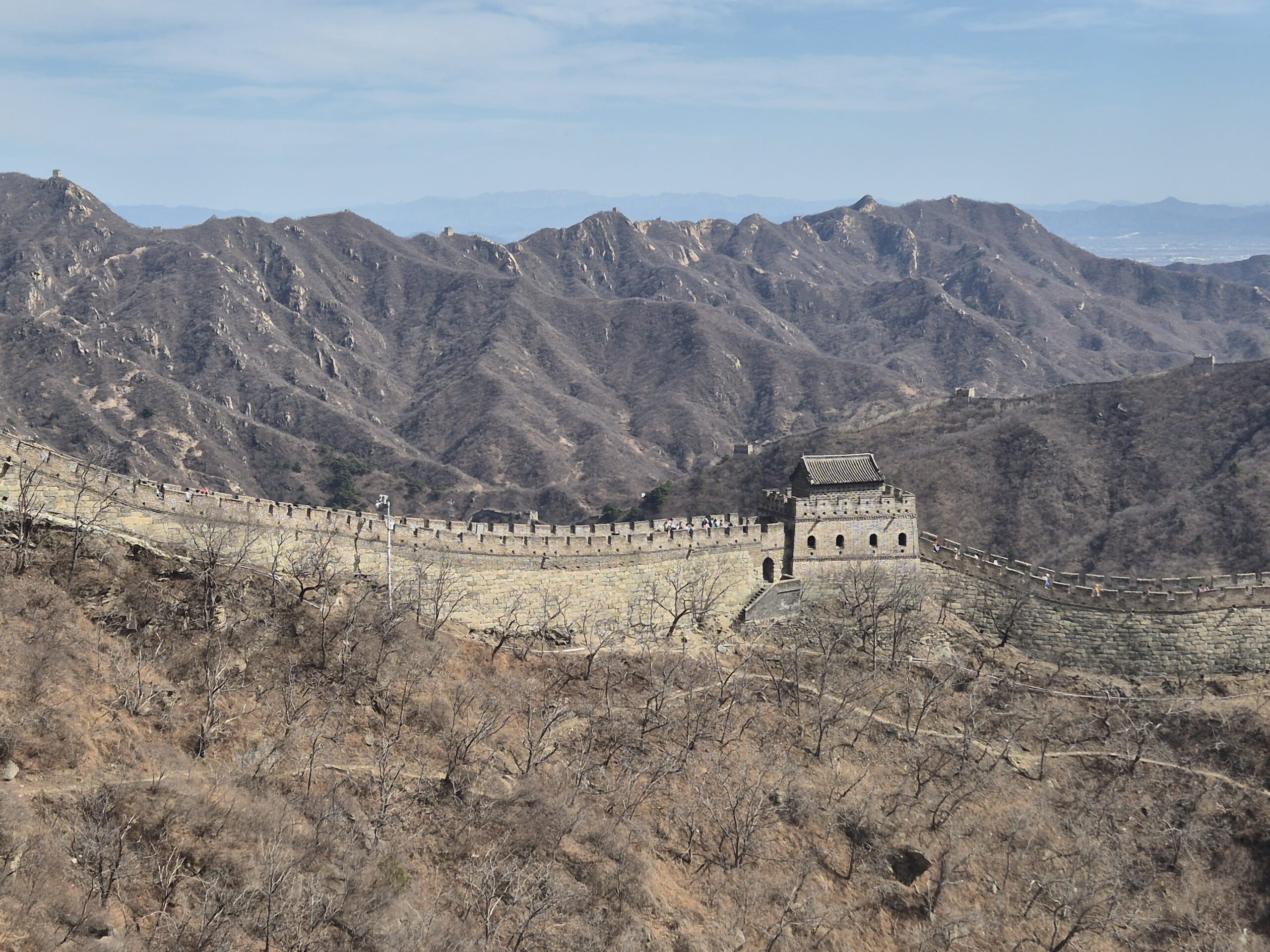How to Get to the Great Wall from Beijing by Public Transport
Beijing is a city where history whispers from every corner, yet it’s also the perfect base for reaching one of the world’s most iconic landmarks – the Great Wall of China. Many visitors assume you need an organized tour, but the truth is you can reach the Wall on your own by using Beijing’s public transport system. It’s cheaper, more flexible, and gives you the chance to travel like a local. And while the Great Wall will take your breath away, don’t miss the opportunity to explore the Temple of Heaven, Tiananmen Square, and the Forbidden City – each offering its own unforgettable window into China’s rich history and vibrant culture. Let’s start with how to get to the Great Wall from Beijing by public transport.

Getting to the Badaling Great Wall by Train
When people think of the Great Wall near Beijing, Badaling usually comes first. It’s the most famous and most visited section, just 70 km northwest of the city. If it’s your very first time at the Wall and you don’t mind some crowds, Badaling is a classic choice.
- Head to Beijing North Railway Station (reachable by metro).
- Take the S2 train line directly to Badaling.
- The ride takes about 80 minutes and costs only a few yuan.
- From Badaling Station, it’s a short walk or shuttle bus to the Wall entrance.
💡 Tip: To get the most out of the Great Wall from Beijing by public transport, sit on the left side of the train for stunning mountain views along the way.

Getting to Mutianyu Great Wall by Bus
Now, if you’d like to experience the Wall with fewer crowds and more greenery, Mutianyu is the section for you. It takes a little longer to reach, but many travelers find it worth the extra effort – especially families and those who prefer a calmer atmosphere.
- Take the 916 Express bus from Dongzhimen Transport Hub to Huairou.
- From there, transfer to a local minibus or taxi to the Mutianyu entrance.
- The trip takes about 2–2.5 hours, depending on traffic.
🚍 From Huairou to Mutianyu – Great Wall from Beijing by public transport
When you arrive in Huairou on the 916 Express, your next bus stop is just across the street. If you continue by local bus, be aware that it doesn’t stop right at the entrance – you’ll still have about a 1-hour walk. Also, sometimes more people are waiting than can fit on the bus, so it’s smart to walk a few minutes back to the previous stop, where you’ll have a better chance of getting on.
Local taxi drivers can be quite persistent. They’ll often cross the street with you and point out exactly where the next bus comes from – all while insisting it won’t arrive for hours. Instead, we chose Didi (the Asian version of Uber – if you have not used this app yet, see essential apps for your China Travel in our Shanghai post). It costs only £3 and arrived in about 7 minutes. While waiting, we saw two buses heading towards the Wall. In the end, it’s up to you: comfort, time, or budget.
Once there, you’ll find gentler slopes, restored sections, a cable car, and even a fun toboggan ride down – perfect for kids (and kids at heart).

🏯 Badaling Great Wall vs Mutianyu Great Wall – Great Wall from Beijing by public transport
| Feature | Badaling | Mutianyu |
|---|---|---|
| Distance from Beijing | ~70 km (80 min by train) | ~70 km (2–2.5 hrs by bus + transfer) |
| Crowds | Very busy, especially weekends & holidays | Much quieter, fewer tourists |
| Accessibility | Easiest to reach (direct train) | A bit trickier (bus + minibus/taxi/Didi) |
| Scenery | Dramatic mountain views, iconic watchtowers | Lush greenery, restored sections, softer slopes |
| Family-friendly features | Steep in places, can be crowded | Cable car + toboggan ride |
| Best for | First-time visitors, short day trips | Families, mindful travelers, less touristy experience |
By this point, you’ve probably already guessed which section of the Wall we’d recommend visiting most – but the choice is yours! Whichever you choose, we recommend taking your time and walking along this piece of history rather than rushing for a quick photo and heading back.
We visited Mutianyu on a regular Friday morning in March, and to our surprise, after just a short walk, we found stretches of the Great Wall completely to ourselves. If the Great Wall of China is on your travel bucket list and you dream of photos without another soul in the background – yes, it’s still possible!

Other Must-See Places in Beijing
While the Great Wall is a highlight, Beijing has much more to offer. Consider visiting the Temple of Heaven, Tiananmen Square, and the Forbidden City on another day to fully appreciate their historical and cultural importance.
Temple of Heaven – A Spiritual Retreat
The Temple of Heaven is a masterpiece of architecture and a symbol of China’s rich cultural heritage. Built in the early 15th century during the Ming Dynasty, it served as a place where emperors prayed for good harvests.
Take your time to explore the expansive grounds, observe locals practicing Tai Chi, and reflect on the historical importance of this sacred site.

Tiananmen Square – The Heart of Beijing
Tiananmen Square, one of the largest public squares in the world, holds profound historical and political significance.
- Entry Requirements: Entry is free, but visitors must register in advance. You can register online or via authorized services using your passport information. Here, you can find a step-by-step guide on how to book your Tiananmen Square visit for free using WeChat mini-program. Please remember to book your ticket a couple of days in advance. You can also pay somebody to register you here – it costs less then 3£.
- Tips: Arrive early to avoid crowds and security delays. Be prepared for thorough security screenings and maintain respectful behavior.
Guess who spent so much time at the Great Wall that there was only enough left to wander along the peaceful Changpu River – without making it into Tiananmen Square? 🙂 That’s exactly why we suggest leaving it for another day. Some places deserve unhurried time, and Tiananmen Square is certainly one of them. Next time!

The Forbidden City – A Glimpse into Imperial Life
The Forbidden City stands as a testament to China’s imperial past. Constructed between 1406 and 1420 during the Ming Dynasty, it served as home to 24 emperors over nearly 500 years. Today, it’s known as the Palace Museum, with over 1.8 million works of art.
Visiting Tips:
- Open daily from 8:30 AM to 5:00 PM, closed Mondays.
- Tickets must be booked in advance, either online or at the gate. Bring your passport.
- Highlights include the Hall of Supreme Harmony, the Imperial Garden, and the Palace of Heavenly Purity.
- Take your time – the Forbidden City is vast, and a slow pace allows for mindful reflection on history and architecture.
The Forbidden City covers approximately 180 acres. It’s easy to feel overwhelmed, but taking your time to explore at a leisurely pace allows you to absorb the history and beauty of each pavilion and courtyard. Remember, it’s not just about seeing the sights but experiencing the stories they tell.


For those enchanted by China’s history and architecture, a visit to the Forbidden City can spark curiosity about other traditional places in the country. Just like a day trip to Zhujiajiao, the Chinese Venice near Shanghai, which showcases serene canals and historic bridges, the Forbidden City immerses you in another facet of China’s rich heritage. Both experiences remind us that mindful travel is about noticing the small details and respecting the culture around us.
What’s the Story Behind Beijing’s Supported Trees?
If you’ve wandered through Beijing and noticed trees with supports holding up their branches, you might have wondered why. As true nature lovers, we were deeply touched by this careful attention.
These trees aren’t just ordinary plants – many are centuries old, living witnesses to the city’s history, culture, and countless stories. For instance, the 3,500-year-old cypress in Miyun District, believed to be the oldest tree in Beijing, has been meticulously preserved. Experts rerouted roads and demolished surrounding structures to protect its roots, ensuring its survival for future generations.
The supports show respect and care, preserving their strength and beauty for future generations. Seeing them made us pause and reflect: even a tree is honored for its resilience and role in the life of the city. It feels so mindful and connected, a quiet reminder that travel isn’t just about monuments, but also about reverence for the life around us.



Hotel Tips in Beijing – Our Experience – Great Wall from Beijing by public transport
Travel is about keeping an open mind – and sometimes that means patience. We booked a non-smoking room in Beijing, but the first few we saw still smelled of cigarettes. Only the fifth room felt truly comfortable.
The staff were incredibly kind and professional, and what this taught us is that it’s good not to give up and to ask for what you need. In China, “non-smoking” often means the room is now designated as such, but furnishings can still carry traces of the past – a small reminder to approach travel with patience.

Mindful Reflections on Traveling in Beijing – Great Wall from Beijing by public transport
Traveling is about being present, curious, and patient. At the Great Wall, take time to walk slowly, notice the ancient stones, the mountains, and the quiet moments – don’t rush for just a photo.
Even small challenges, like finding a truly non-smoking hotel room, can teach patience and cultural awareness. After a few rooms that still smelled of cigarettes, the fifth room was finally right – a reminder that it’s good not to give up and to ask for what you need.
At the Temple of Heaven, Tiananmen Square, and the Forbidden City, pause to watch, reflect, and absorb the history around you. Mindful travel is about balancing curiosity with patience and letting every experience, planned or unexpected, become part of your journey.

What else to do in Beijing? – Great Wall from Beijing by public transport
Wondering what else to do in Beijing? Discover more must-see sights and experiences in the city. If you prefer a guided adventure, you can also book an organized Great Wall trip – group tours start at around £15.
What else to see in China?
If you have more time, exploring beyond Beijing reveals even more of China’s charm. Shanghai, for example, offers a mix of history and modern excitement. You can wander through the tranquil Yu Garden, admire the skyline from Shanghai Tower, or even enjoy quirky dining experiences like a restaurant with a Ferrari hanging from the ceiling. For a glimpse of traditional waterways and bridges, a day trip to Zhujiajiao, the Chinese Venice, is unforgettable.
From the winding stretches of the Great Wall to the tranquil streets of historic towns, every step in China invites you to pause, breathe, and witness the harmony of past and present gently unfolding around you.

Keep the Adventure Going
Get tips, guides, and insights to make your trips more mindful and memorable:
- Facebook: JourneyJoy.org Travel Blog
- Instagram: @journeyjoy_blog
Discover ideas that help you explore fully, pause meaningfully, and enjoy every moment of your journey.

Ready to plan your own adventure? Visit our How to Book Your Holiday Online guide for simple steps to turn travel dreams into reality.


